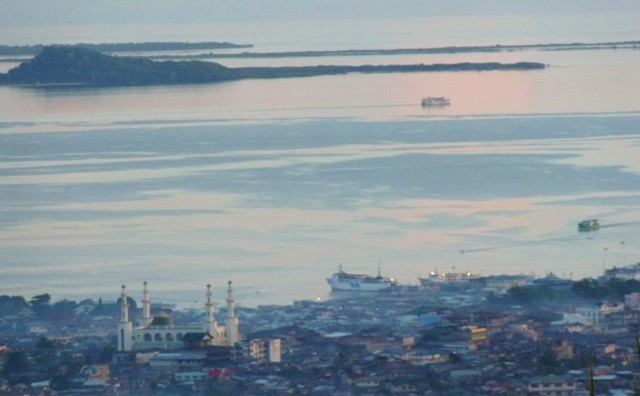This is what makes Bud Datu special, a hilltop base just outside the small capital of Sulu province, which has seen the constant turnover of military posts as a strategic location. It was the military’s idea in recent years to turn this restricted area into a tourist spot.

Before the outbreak of the separatist rebellion in the 1970s, this was a park for picnics, as I had remembered it from my early childhood. And when I find myself again on this island, I never fail to visit Bud Datu.
As you make your way up, past the checkpoints from the road, the atmosphere changes with the scent of the forest and the monkeys surprising you out of nowhere. On my latest trip in April, I saw more birds than I had recalled: an oriole, a drongo, and some bulbuls and fantails.
We start the trail-walk at dawn. My friend, a Marine officer who has known this camp since he was a company commander more than 12 years ago, and I had shared memories of this place when it was almost rundown. Back then, the only thing that held us together was the surreal view of Jolo.
He was waiting on the balcony with a cup of coffee, the sunrise peeking from the corner east. I stayed in the ‘guest house,’ a new structure built alongside the officers’ quarters from a mere bunker that an Army officer from a previous billeting had started with a vision of making Bud Datu an eco-tourism site, to show people the pride of this island once again.
It used to be that I slept in a folding cot in a room – somewhat musty and dark – that had seen soldiers come and go. This time around, I had a real bed with fresh sheets and a blanket, and the blessed cool mountain air flowing through the window. I had the urge to decorate the place, paint it with colors of my liking, remove the tawdry curtains.
The room has a kitchenette, a dining table, and an adjacent dressing room leading to a bathroom with a shower, a rarity in most camps. When I asked the commander if there were any peculiarities that I should know about – because I have experienced far too many bathrooms in army outposts – he simply said, “the toilet flushes.” We both know what that means in terms of luxury.
It had been an out of the ordinary thing to do, for the military at that. But it caught on; not only did the guesthouse become a reality, the burial shrine nearby of a famous rajah of Sulu’s golden history was renovated into a site for a pilgrimage, surrounded by a park of fairy tale-like gazebos and fragrant ylang-ylang trees.
When it rains, as it usually does, the red soil of Bud Datu washes down in a stunning image of nature. The rain itself could make you feel transported into another world, and all you could do is watch it with certain awe.
The military is not spouting propaganda when it says this place is a haven for bio-diversity; as we take our morning walk around the camp, I could only guess the kind of excitement that would overwhelm a botanist or an ornithologist. The trail is still muddy from yesterday’s rain, and the dried leaves that had fallen gave the ground a sheen of autumn.
The porch has a pretty birdcage and a well-tended garden. In addition to this new, pleasant surrounding, there’s a gallery of nature photography that shows what Bud Datu is all about. If not for the howitzers planted on flat ground across the camp, everything would have appeared as normal as one would hope about Sulu.
But here, on top of this little world, I am extremely content; after the early morning walk, a stroll to the shrine, and a bit of bird watching, breakfast is ready on the balcony. Just as I guessed, paco ferns freshly picked from the forest are served, a specialty when I am around.
It is made into a salad; it had slipped my mind to give the ward boy an omelet recipe. Next time around, I would not be surprised if Camp Bud Datu comes up with its own menu for guests, who might get a strange pleasure of seeing Jolo at a quiet distance, a view that never seems to change, and they may wonder about the point of all the wars. – YA, GMA News
Visitors who want to see Bud Datu may inquire from the mayor’s office or the provincial capitol in Jolo. Air Philippines flies to Jolo three times a week from Zamboanga City, where inquiries can also be made at the regional tourism department beside the Lantaka Hotel By the Sea.

No comments:
Post a Comment